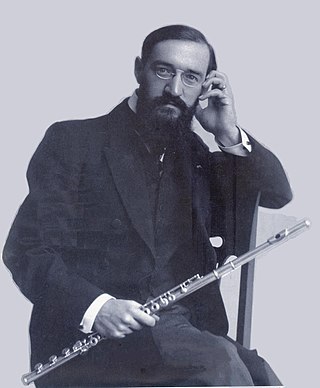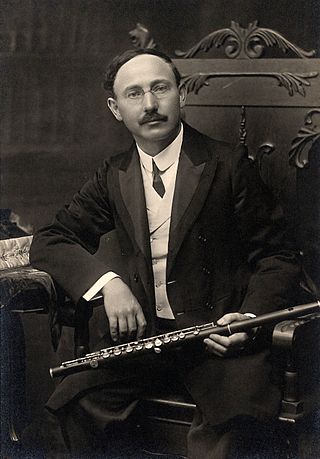Related Research Articles

The NBC Symphony Orchestra was a radio orchestra conceived by David Sarnoff, the president of the Radio Corporation of America, the parent corporation of the National Broadcasting Company especially for the conductor Arturo Toscanini. The NBC Symphony Orchestra performed weekly radio broadcast concerts with Toscanini and other conductors and several of its players served in the house orchestra for the NBC Radio Network. NBC encouraged the public’s perception of the Orchestra as a full-time organization exclusively at Toscanini’s beck and call, but Fortune disclosed in 1938 that these instrumentalists played other radio—and, later, television—broadcasts: “the Toscanini concerts have been allocated only fifteen of the thirty hours a week each man works, including rehearsals.”
Ellen Taaffe Zwilich is an American composer, the first female composer to win the Pulitzer Prize for Music. Her early works are marked by atonal exploration, but by the late 1980s, she had shifted to a postmodernist, neoromantic style. She has been called "one of America's most frequently played and genuinely popular living composers." She was a 1994 inductee into the Florida Artists Hall of Fame. Zwilich has served as the Francis Eppes Distinguished Professor at Florida State University.
Julius Baker was one of the foremost American orchestral flute players. During the course of five decades he concertized with several of America's premier orchestral ensembles including the Chicago Symphony and the New York Philharmonic Orchestra.
William Ingham Brooke Bennett was a British flautist and teacher. He played in many English orchestras and chamber music ensembles, and as a soloist. He made more than 100 recordings, including chamber music with partners including George Malcolm, Osian Ellis, and Yehudi Menuhin. He premiered flute concertos written for him, by William Mathias, Diana Burrell and Raimundo Pineda. Bennett taught at the Hochschule für Musik Freiburg in Germany and the Royal Academy of Music, and held master classes worldwide.
Bülent Evcil is a Turkish solo flutist and is the winner of the Royal Belgium Encouragement Medal of Art. He received the second place award in the Best Overall Performer Award at the 4th James Galway International Flute Seminar in Dublin.

Charles Moïse Léon Salzedo was a French harpist, pianist, composer and conductor. His compositions presented the harp as a virtuoso instrument. He influenced many composers with his new ideas for the harp's sounds, and was influential in New York's new music scene through his work leading the International Composers' Guild with Edgard Varèse.

Albert Frederic Stoessel was an American composer, violinist and conductor.

Ransom Wilson is an American flutist, conductor, and educator.
Frances Blaisdell was an American flautist, widely recognized as one of the first female professional flautists. She held positions with the National Orchestral Association, the New Opera Company and the New Friends of Music. In addition, she was the first woman to appear as a soloist and wind player in concert with the New York Philharmonic. In addition to playing, she also held teaching positions at the Manhattan School of Music, New York University, Dalcroze School, Mannes School of Music, and Stanford University where she taught for over 35 years. Blaisdell's teachers included Georges Barrère, Marcel Moyse and William Kincaid.

Georges Barrère was a French flutist.
Jacques Zoon is a Dutch flutist.
Robert Neil Cavally was an American flutist who trained and inspired many noted flute performers and teachers, and edited many solos and etudes for use by teachers. He was an eloquent writer and woodworker.
Marina Piccinini is an Italian American virtuoso flautist. She is noted for her performances of compositions by Mozart and Bach, and has performed with many of the world's top orchestras and conductors.
Lamar Edwin Stringfield was a classical composer, flutist, symphony conductor, and anthologist of American folk music.

Leonardo De Lorenzo was an Italian virtuoso flutist and music educator.

William Morris Kincaid was an American flutist and teacher. He is known for his work as principal flute of the Philadelphia Orchestra for almost 40 years, teaching at the Curtis Institute and being a guiding force in the creation of an American School of flute playing.
Leone Buyse was the Joseph and Ida K. Mullen Professor of Flute and Chair of Woodwinds at Rice University's Shepherd School of Music. Prior to a full-time career teaching, Buyse spent over 22 years as an orchestral flutist, including a decade from 1983-1993 as Principal Flute of the Boston Symphony Orchestra and Boston Pops Orchestra. Other orchestral positions include Rochester Philharmonic as solo piccolo and second flute, and assistant principal of San Francisco Symphony. In addition to the Shepherd School, she has held faculty positions at the New England Conservatory, Boston University, University of Michigan, as visiting professor at the Eastman School of Music and numerous summer festivals including the Tanglewood Institute. Her primary teachers include Marcel Moyse, Jean-Pierre Rampal, Michel Debost and Joseph Mariano.
Ruth Freeman Gudeman was an American flutist and teacher. She is credited as the first woman to give a major solo recital in New York City at Town Hall. She received a Bachelor of Music degree from the Oberlin Conservatory and held a fellowship at the Juilliard School of Music, where she studied with George Barrère over a fourteen-year period. Italian flutist and educator Leonardo de Lorenzo called her "one of America's finest flutists."

Robert Murchie was a virtuoso British flautist and a prominent member of the major English orchestras between 1914 and 1938. He was successively principal flautist in the New Symphony, Beecham Symphony, Queen's Hall, New Queen's Hall, London Symphony, Royal Philharmonic Society, BBC Symphony and London Philharmonic Orchestras. In 1926 he founded a chamber ensemble of leading wind players known as the London Wind Quintet. He was described by Sir Henry Wood as "one of the finest of living flautists" who said he had "a tone, a technique and a musicianly style that cannot be surpassed". In her book 'The Flute Book', by Nancy Toff, she describes Murchie thus: The English style of flute playing reached its apogee in the playing of Robert Murchie, perhaps the premier London flautist between the two world wars.
References
Citations
Bibliography
- De Lorenzo, Leonardo (1992). "Lora, Arthur". My Complete Story of the Flute : the Instrument, the Performer, the Music. Texas Tech University Press.
- Maclagan, Susan J. (2009). "Lora, Arthur". A Dictionary for the Modern Flutist. Scarecrow Press. p. 104.
- Mize, J.T.H., ed. (1951). The International Who is Who in Music, Fifth (Mid-Century) Edition. Who's Who in Music Inc.
- Toff, Nancy (2005). Monarch of the Flute: the Life of Georges Barrère. Oxford University Press.
- Toff, Nancy (2012). The Flute Book : a Complete Guide for Students and Performers. Oxford University Press.
- Rolland, Romain; Lalo, Pierre, eds. (1965). "Lora, Arthur". The International Library of Music For Home and Studio: Volume II, Music Literature. The University Society Inc.